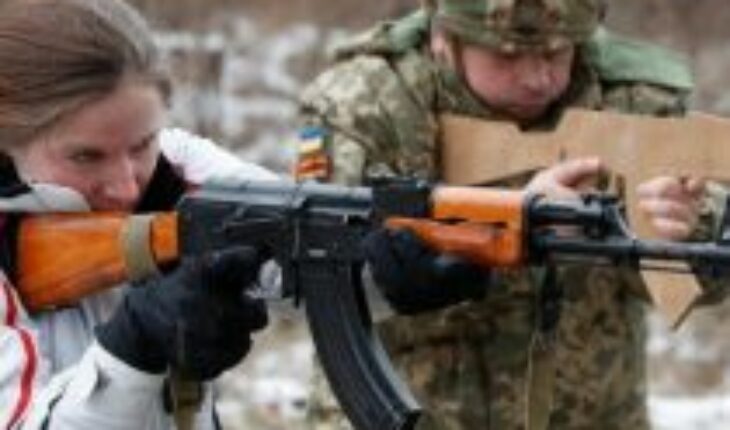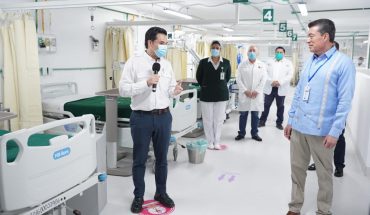From Monday to Friday, Mykhaylo is a lawyer, Alexander is an IT programmer and Konstantin works as a freelancer in online advertising.
On Saturday, the three gathered at an abandoned construction site on the outskirts of Kiev to train as Ukrainian army reservists, ready to be called in case a war breaks out with neighboring Russia.
Nervous about the threat of some 120,000 Russian troops gathered near the border with Ukraine, Kiev has launched a new Territorial Defense force this year, which it wants to turn into a corps of up to 130,000 people.
While they may have little chance against a much larger and better-equipped Russian army, reservists like them could be tasked with protecting concentrated civilian areas like Kiev in the midst of any conflict.
Saturday’s training brought together about 70 locals, some with full infantry equipment with hunting rifles and combat experience when Russia annexed Crimea in 2014 and then backed rebels fighting government troops in eastern Ukraine.
Other volunteers in sneakers and casual sportswear were given simulated wooden rifles.
“I’m worried,” said Konstantin Sevchuk, the 43-year-old freelancer who said he had so far avoided any contact with the army after serving a year in the eastern Donbass region in 2014, during Ukraine’s general mobilization.
“It doesn’t really fit into my life, I really didn’t want it. But now the situation is such that I need it.”
While IT programmer Alexander participated in the 2013/2014 “Maidan” mass pro-democracy protests in Kiev, he said he did not feel ready to fight when Moscow reacted to the overthrow of Ukraine’s pro-Russian president, annexing Crimea.
“I’m in my mid-30s now and it’s time for me to join,” he said, his face covered in a blue scarf. “It’s better to join now than when it’s too late. I want to be prepared.”
Breathing heavily after getting up and lying on the snow-covered ground several times with his heavy equipment, Mykhaylo, 39, was excited to go fighting.
“My inclination towards warships has been there long before the war. Now it makes a lot of sense to do it,” he said during the exhibition exercises.
While the United States has warned that military intervention is likely and imminent, Ukrainian President Volodymyr Zelenskiy has said too much “panic” is hurting the economy of 41 million people.
Russian President Vladimir Putin says the West has not addressed Moscow’s main security demands in the Ukraine crisis, but is willing to continue dialogue.
Russia’s military supply near Ukraine was expanded to include blood for transfusions along with other medical materials that would allow it to treat wounded, another sign of Moscow’s war readiness, three U.S. officials told Reuters.
U.S. officials and former officials have said concrete signals — such as blood supplies — are critical in determining whether Moscow would be prepared to carry out an invasion, if Russian President Vladimir Putin chooses.
The revelation by U.S. officials, who spoke on condition of anonymity, adds another piece of context to growing U.S. warnings that Russia may be preparing for a new invasion of Ukraine, with more than 100,000 troops near its borders.
The warnings have included President Joe Biden’s prediction that a Russian assault was likely and comments by U.S. Secretary of State Antony Blinken that Russia could launch a new attack on Ukraine in “a very short time.”
The Pentagon has previously acknowledged the deployment of “medical support” as part of Russia’s military buildup. But the revelation of blood supplies adds a level of detail that experts say is critical to determining Russian military readiness.
“It doesn’t guarantee there’s going to be another attack, but you wouldn’t execute another attack unless you have that in hand,” said Ben Hodges, a retired U.S. lieutenant general who now works at the Center for European Policy Analysis research institute.
The Russian Defense Ministry did not immediately respond to awritten comments.
A White House spokesman did not immediately comment on any Russian moves, but insisted on repeated public U.S. warnings about Russian military readiness.
The Pentagon declined to discuss intelligence assessments.
The three U.S. officials who spoke about the blood supplies declined to say specifically when the U.S. detected their movement in formations near Ukraine. However, two of them said it was in recent weeks.
Russian officials have repeatedly denied that they plan an invasion.
War is only possible if Belarus or Russia are attacked, Lukashenko says
Belarusian leader Alexander Lukashenko said Friday that Minsk has no interest in a war and that the conflict would only erupt if Belarus or its close ally Russia were directly attacked.
Lukashenko made the remarks in a speech to Belarusian parliamentarians and leaders. Moscow and Minsk are set to hold joint exercises next month in Belarus, north of Ukraine, which have unsettled Western powers in a context of increased Russian military build-up.
The Belarusian leader said the military exercises will help Minsk understand where it has to concentrate forces and that Belarus has to protect its southern flank with Ukraine.





